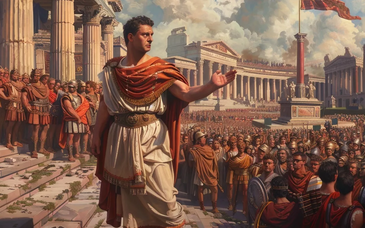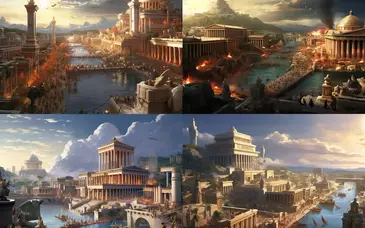The atrocities of the First Slave War were anything but forgotten when in 103 BC the slaves of Sicily dared to revolt again. That after the cruelty in the aftermath of the first conflict they dared to rise again, hints how bad their conditions must have been.
They fought so stubbornly that it took Rome 3 years to stamp out the revolt.
The Second Slave War
You Might Also Like:
Gaius Marius Marius, Gaius (circa 157-86BC), Roman general and statesman, who led the Populares during the civil war of 88-86BC.
Caius Marius (died 86 B.C.E.)
By PlutarchWritten 75 A.C.E.Translated by John Dryden
We are altogether ignorant of any third name of Caius Marius; as also of Quintus Sertor
...
Read More
The eclipse of the Roman Empire in the West (c. 395-500) and the German migrations
Invasions in the early 5th century
The barbarian invasions.
After the death of Theodosius the Western empire was governed by young Honorius. Stilicho, an experienced statesman and general, was charged with assisting...
Read More

Read More
The Latin words res publica which mean 'commonwealth' or 'state' is the source of today's term 'republic'.Rome was never a democracy as we would understand it today, nor as the Greeks understood it. For Roman society and the power within it was firmly divided by class.Most obviously, there was a div...
Read More

Read More
Ancient Rome was a powerful civilization that existed from 753 BCE to 476 CE. It was located in the central part of the Italian peninsula and was known for its military prowess, political and legal systems, and architectural and engineering achievements.
Ancient Rome is considered to be one of the m...
Read More
The year 12 CE might not be the flashiest moment in Roman history, but it offers a fascinating snapshot of a powerful empire in its prime. We're not quite at the reign of Trajan, the period of maximum extent, but let's delve into what the Roman world looked like in this specific year.Augustus: Stil...
Read More

Read More
The Roman civilization was one of the most influential in world history, and its impact can still be felt today in areas such as politics, architecture, language, and law. The Roman Republic, which was established in 509 BCE, was the first known republic in the world, and it laid the foundation for ...
Read More
Rome, as the capital of the Roman empire, was the most important city. The city grew and so it became occupied by important buildings. These buildings are all built close to each other making a center for entertainment and other causes like political leaders going to the Forum. These buildings are t...
Read More
The Coliseum - a comparison of pictures taken during the 1960s and in August 1996...
A Timeless Icon: The Colosseum Then and Now
The Colosseum, a symbol of ancient Rome's power and grandeur, continues to captivate visitors centuries after its construction. Comparing photographs from different eras o...
Read More

Read More
The first time I saw the Pantheon, it seemed huge. The roof high above me with the light coming in lines was incredible as I had not yet seen such an incredible structure. When I went on the eleventh grade field week I saw it from the outside and even though I have grown I am still amazed at its bea...
Read More
Note: Though this map states that the Roman Empire was at its greatest extent in the third century A.D., Mesopotamia, shown here as part of the empire, was only briefly part of the Roman world during the last years of the reign of Trajan (emperor A.D. 98-117) and was abandoned immediately after his ...
Read More
Lucius Aurelius Commodus on 31 August AD 161 at Lanuvium, roughly 14 miles south-east of Rome.Of the fourteen children of Marcus Aurelius and Faustina the Younger, Commodus was the tenth. He was born one of twins, though his twin brother died when he was only four years old. He was given the Commodu...
Read More
Lucius Domitius Aurelianus was born of poor parents on 9 September AD 214 in Lower Moesia.His father was a tenant farmer of a wealthy senator Aurelius, after whom the family were named.
Aurelian rose through the ranks of the army, serving with distinction on the Danube frontier.By AD 268, when Aureo...
Read More
As in any large society with growing sophistication and complexity there arises the need for ever more governmental offices to oversee and regulate aspects of life.In the Roman Republic the following offices were created in order to deal with the expanding demands on government.
Consul (Head of Sta...
Read More
The SenateComitia CuriataComitia CenturiataComitia TributaConcilium PlebisThe Senate had roughly 300 members. In the very early days of Roman history entry to the senate was by birth or rank. Later it was the consuls who nominated new members to the senate.
Plebeians gained entry in the course of th...
Read More
ConsulDictatorPontifex MaximusCensorPraetorAedileQuaestorThe Roman republic was led by two Consuls who were joint heads of the Roman state and commanders-in-chief of the army. They were elected only for one year and thereafter could not be re-elected again for 10 years, in order to prevent any form ...
Read More